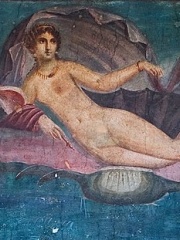

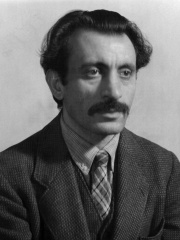
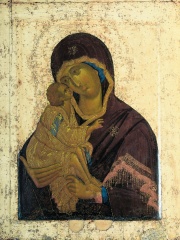
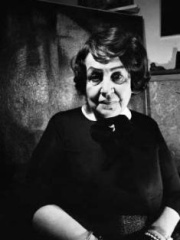


The Most Famous
PAINTERS from Turkey
Top 8
The following people are considered by Pantheon to be the most legendary Turkish Painters of all time. This list of famous Turkish Painters is sorted by HPI (Historical Popularity Index), a metric that aggregates information on a biography’s online popularity.

1. Apelles (-370 - -306)
With an HPI of 69.72, Apelles is the most famous Turkish Painter. His biography has been translated into 43 different languages on wikipedia.
Apelles of Kos (; Greek: Ἀπελλῆς; fl. 4th century BC) was a renowned painter of ancient Greece. Pliny the Elder, to whom much of modern scholars' knowledge of this artist is owed (Naturalis Historia 35.36.79–97 and passim), rated him superior to preceding and subsequent artists. He dated Apelles to the 112th Olympiad (332–329 BC), possibly because he had produced a portrait of Alexander the Great.

2. Parrhasius (-500 - -460)
With an HPI of 59.19, Parrhasius is the 2nd most famous Turkish Painter. His biography has been translated into 20 different languages.
Parrhasius of Ephesus (Greek: Παρράσιος) was a famed painter of Ancient Greece. Zeuxis, Timanthes and Parrhasius were painters who belonged to the Ionian School of painting. The Ionian School flourished during the 4th-century BCE.

3. Arshile Gorky (1904 - 1948)
With an HPI of 59.01, Arshile Gorky is the 3rd most famous Turkish Painter. His biography has been translated into 36 different languages.
Arshile Gorky ( AR-sheel GOR-kee; born Vostanik Manoug Adoian, Armenian: Ոստանիկ Մանուկ Ատոյեան; April 15, 1904 – July 21, 1948) was an Armenian-American painter who had a seminal influence on Abstract Expressionism. He spent the last years of his life as a national of the United States. Along with Mark Rothko, Jackson Pollock and Willem de Kooning, Gorky has been hailed as one of the most powerful American painters of the 20th century. The suffering and loss he experienced in the Armenian genocide had crucial influence at Gorky's development as an artist.

4. Theophanes the Greek (1340 - 1410)
With an HPI of 58.88, Theophanes the Greek is the 4th most famous Turkish Painter. His biography has been translated into 30 different languages.
Theophanes the Greek (Russian: Феофан Грек, romanized: Feofan Grek; Greek: Θεοφάνης; c. 1340 – c. 1410) was a Byzantine Greek artist and one of the greatest icon painters of Muscovite Russia, who influenced the 15th-century painting style of the Novgorod school and the subsequent Moscow school. He was noted as the teacher and mentor of the great Andrei Rublev.
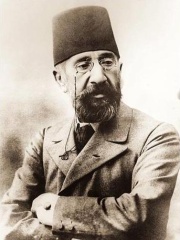
5. Osman Hamdi Bey (1842 - 1910)
With an HPI of 55.45, Osman Hamdi Bey is the 5th most famous Turkish Painter. His biography has been translated into 26 different languages.
Osman Hamdi Bey (30 December 1842 – 24 February 1910) was an Ottoman administrator, intellectual, art expert and also a prominent and pioneering painter. He was the Ottoman Empire's first modern archaeologist, and is regarded as the founding father of both archaeology and the museum curator's professions in Turkey. He was the founder of Istanbul Archaeology Museums and of the Istanbul Academy of Fine Arts (Turkish: Sanayi-i Nefise Mektebi) known today as the Mimar Sinan Fine Arts University. He was also the first mayor of Kadıköy.

6. Princess Fahrelnissa Zeid (1901 - 1991)
With an HPI of 54.40, Princess Fahrelnissa Zeid is the 6th most famous Turkish Painter. Her biography has been translated into 22 different languages.
Princess Fahrelnissa Zeid (Arabic: فخر النساء زيد, Fakhr un-nisa or Fahr-El-Nissa, born Fahrünissa Şakir; 7 January 1901 – 5 September 1991) was a Turkish artist best known for her large-scale abstract paintings with kaleidoscopic patterns as well as her drawings, lithographs, and sculptures. Zeid was one of the first women to go to art school in Istanbul. She lived in different cities and became part of the avant-garde scenes in 1940s Istanbul, and post-war Paris, there becoming part of the new School of Paris. Her work has been exhibited at various institutions in Paris, New York, and London, including the Institute of Contemporary Art in 1954. In the 1970s, she moved to Amman, Jordan, where she established an art school. In 2017, Tate Modern in London organised a major retrospective and called her "one of the greatest female artists of the 20th century". Her largest work to be sold at auction, Towards a Sky (1953), went for just under one million pounds in 2017. Her record is the USD 2,741,000 sale of her Break of the Atom and Vegetal Life (1962) in 2013 by Christies. In 1920, Şakir married Izzet Devrim, with whom she had three children: Faruk, Nejad, and Şirin. Şakir divorced Devrim in 1934. The same year, she married Prince Zeid bin Hussein, a member of the Hashemite royal family of Iraq. They were the parents of Prince Ra'ad bin Zeid.

7. Echion (-350 - -400)
With an HPI of 53.53, Echion is the 7th most famous Turkish Painter. His biography has been translated into 15 different languages.
Echion (Ancient Greek: Έχίων), also known as Aetion (Ἀετίων), was a celebrated Greek painter spoken of by Lucian, who gives a description of one of his pictures, representing the marriage of Alexander the Great and Roxana. This painting excited such admiration when exhibited at the ancient Olympic Games, that Proxenidas, one of the judges, gave the artist his daughter in marriage. Echion seems to have excelled particularly in the art of mixing and laying on his colors. It has commonly been supposed that he lived in the time of Alexander the Great; but the words of Lucian show clearly that he must have lived about the time of Hadrian and the Antonines. Aloys Hirt supposes that the name of the painter of Alexander's marriage, whom Lucian praises so highly, as Aetion, is a corruption of Echion. Sandro Botticelli drew on Lucian's ekphrasis in his Mars and Venus (c. 1485, now National Gallery), borrowing the amoretti playing with Alexander's armour during the ceremony, two carrying his lance and one who has crawled inside his breastplate.

8. Iaia (-100 - )
With an HPI of 50.98, Iaia is the 8th most famous Turkish Painter. Her biography has been translated into 15 different languages.
Iaia of Cyzicus (Greek: Ιαία της Κυζίκου), sometimes (incorrectly) called Lala or Lalla, or rendered as Laia or Maia, was a Greek painter born in Cyzicus, Roman Empire, and relatively exceptional for being a woman artist and painting women's portraits. She was alive during the time of Marcus Terentius Varro (116–27 BC). In De Mulieribus Claris, his book of women's biographies, Boccaccio refers to her as "Marcia", possibly confusing her with the Vestal Virgin of that name. According to Pliny the Elder: "No one had a quicker hand than she in painting". Most of her paintings are said to have been of women. Pliny attributes to her a large panel painting of an old woman and a self-portrait. She was said to have worked faster and painted better than her male competitors, Sopolis and Dionysius, which enabled her to earn more than them.
Pantheon has 8 people classified as painters born between 500 BC and 1904. Of these 8, none of them are still alive today. The most famous deceased painters include Apelles, Parrhasius, and Arshile Gorky. As of April 2022, 2 new painters have been added to Pantheon including Echion and Iaia.
Deceased Painters
Go to all Rankings
Apelles
370 BC - 306 BC
HPI: 69.72
Parrhasius
500 BC - 460 BC
HPI: 59.19
Arshile Gorky
1904 - 1948
HPI: 59.01
Theophanes the Greek
1340 - 1410
HPI: 58.88
Osman Hamdi Bey
1842 - 1910
HPI: 55.45
Princess Fahrelnissa Zeid
1901 - 1991
HPI: 54.40
Echion
350 BC - 400 BC
HPI: 53.53
Iaia
100 BC - Present
HPI: 50.98

Newly Added Painters (2022)
Go to all RankingsWhich Painters were alive at the same time? This visualization shows the lifespans of the 3 most globally memorable Painters since 1700.





